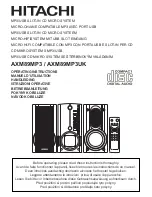
page 7
PHONIC CORPORATION Helix Board 18 FireWire User's Manual
Rear Panel
11. Channel Inserts
Located on the rear of the Helix Board 18 FireWire,
the primary use for these TRS phone jacks is for
the addition of external devices, such as dynamic
processors or equalizers, to mono input channels 1
through to 6. This will require a Y cord that can send
(pre-fader and pre-EQ) and receive signals to and
from an external processor. The tip of the TRS plug
is for sending of the signal to the external device, the
ring is for return of the
signal to the Helix Board
18 FireWire, and the
Sleeve is the grounding.
12. Control Room Outputs
These two 1/4" phone jack outputs feed the signal
altered by the Control Room / Phones level control on
the face of the mixer. This output has extensive use,
as it can be used to feed the signal from the mixer to
an active monitor, for the monitoring of the audio signal
from within a booth, or, alternatively, for the addition of
external signal processing devices or mixers, as well as
acting as a “side fill” output, supplying audio to indoor
areas that the main speakers do not reach. When
using the FireWire interface, this
output can be elected to be fed the
audio signal from the Computer,
for monitoring of recording audio.
13. Group Out
These balanced 1/4" TRS phone jacks output the final
feed from the Group 1 and 2 Faders on the main mixer.
These outputs can be used to feed a wide range of
devices, such as mixers, signal processors, and even
to connect an amplifier and speakers to be used along
with the Main Speakers, for a more rounded audio
experience.
14. Main Out
These two XLR ports will output
the final stereo line level signal
sent from the main mixing bus.
The primary purpose of these
jacks is to send the main output to external devices,
which may include power amplifiers (and in-turn,
a pair of speakers), other mixers, as well as a wide
range of other possible signal processors (equalizers,
crossovers, etcetera).
15. FireWire Connections
The two FireWire connectors are for linking the Helix
Board 18 FireWire to a PC or Macintosh computer. It
will allow 16 channels to be streamed to the computer
(the amount of channels you are able to record
simultaneously depends on the DAW software used),
and 2 audio channels of the computer to be returned
to the mixer. Please observe the FireWire section of
this manual for more information.
16. Power Connector
This port is for the addition of a power cable,
allowing power to be supplied to the mixer.
Please use the power cable that is included
with this mixer only. The Helix Board 18
FireWire features a switching power supply,
suitable for all zones.
Controls and Settings
Rear Panel
17. Phantom Power Switch
When this switch is in the on position, it
act48V of phantom power for all
microphone inputs, allowing condenser
microphones (well, the ones that don’t
use batteries) to be used on these channels. Activating
Phantom Power will be accompanied by an illuminated
LED above the left channel Level Meter. Before
turning Phantom Power on, turn all level controls to a
minimum to avoid the possibility of a ghastly popping
sound from the speakers.
NB.
Phantom Power should be used in conjunction with balanced
microphones. When Phantom Power is engaged, single ended
(unbalanced) microphones and instruments should not be used
on the Mic inputs. Phantom Power will not cause damage to most
dynamic microphones, however if unsure, the microphone’s user
manual should be consulted.
18. Power Switch
This switch is used to turn the mixer on and off. Ensure
you turn all level controls down before activating.
Channel Controls
19. Low Cult Filter (75 Hz)
This button will activate a high-pass
filter that reduces all frequencies
below 75 Hz at 18 dB per Octave,
helping to remove any unwanted
ground noise or stage rumble. On stereo channels
7/8 and 9/10, the low cut filter affects only the XLR
Microphone inputs (and not the line inputs).
20. Line/Mic Gain Control
This controls the sensitivity of the input signal of the
Line/Microphone input. The gain should be adjusted
to a level that allows the maximum use of the audio,
while still maintaining the quality of the feed. This can
be accomplished by adjusting it to a level that will
allow the peak indicator occasionally illuminate.
21. High Frequency Control
This control is used to give a shelving
boost or cut of �15 dB to high frequency
�15 dB to high frequency
(12 kHz) sounds. This will adjust the amount of treble
included in the audio of the channel, adding strength
and crispness to sounds such as guitars, cymbals,
and synthesizers.
11
12
13
16
17
18
19
20
14
15
21








































